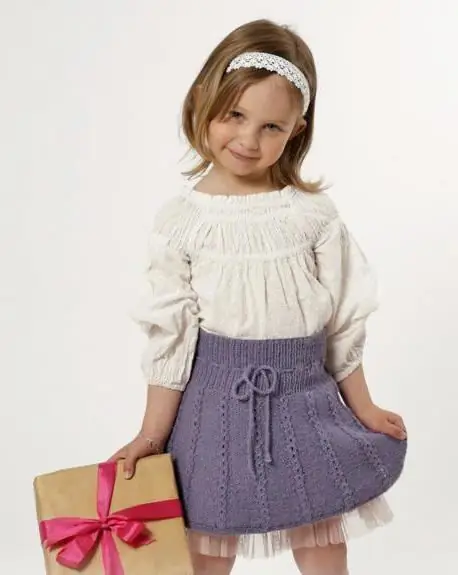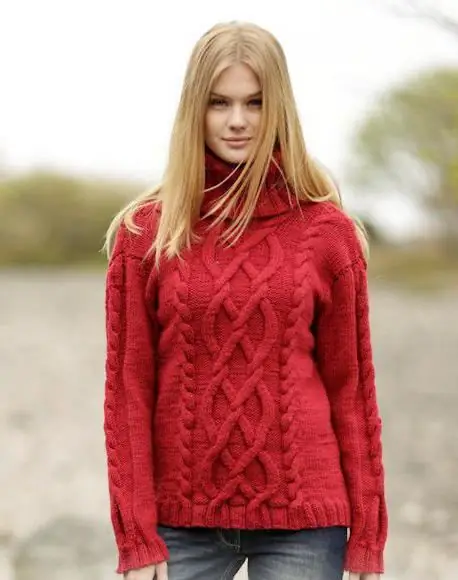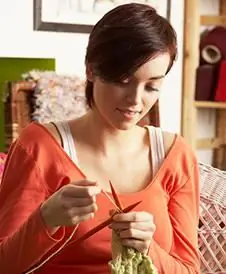
Inhaltsverzeichnis:
- Autor Sierra Becker [email protected].
- Public 2024-02-26 04:44.
- Zuletzt bearbeitet 2025-01-22 22:11.
Alle Liebhaber des Strickens haben unbedingt auf die Schönheit und Vielf alt dieser Art von Mustern geachtet, wie z. B. Zöpfe, die mit Stricknadeln hergestellt werden. Diese Muster können völlig unterschiedlich aussehen. Von zarten, dünnen Zöpfen auf Babyschuhen bis hin zu komplexen, ineinander verschlungenen Aran-Strickmustern. Basierend auf dem einfachen Prinzip der sich kreuzenden Maschen wurden eine Vielzahl verschiedener Arten und Muster von Strickzöpfen erfunden.
Varianten des Zopfmusters

Es gibt verschiedene Arten dieser Muster: Zöpfe selbst, Zöpfe und Aran. Sie unterscheiden sich nicht nur in Aussehen und Komplexität, sondern auch in der Ausführungstechnik. Aber alle eint eine gemeinsame Nuance: Beim Stricken nach dem Zopfmuster mit Stricknadeln kreuzen sich die Maschen des Musters auf jeden Fall.
Zeichnungen von Zöpfen sind dicht, strukturiert und sehr elegant. Sie werden sowohl zum Stricken von Kinderkleidung als auch für Modelle für Erwachsene ausgewählt. In letzter Zeit sind Snood-Sets und geflochtene Hüte sehr beliebt.
Technik zum Stricken des Zopfmusters

Wenn verschiedene Arten von Zöpfen gestrickt werden, wird eine Technik verwendet, die Maschen des Musters werden gekreuzt, wodurch ein Muster entsteht.
Zum Stricken nach einem der einfachsten Zopfmuster mit Stricknadeln benötigen Sie die sogenannte zusätzliche Stricknadel. Profi-Zusatznadeln haben ein in Form einer Schlaufe abgerundetes Ende, was ein Abrutschen der entfernten Schlaufen verhindert und das Arbeiten erleichtert. Aber wenn es keine gibt, Sie es aber versuchen möchten, können Sie eine normale Stricknadel oder eine Sicherheitsnadel verwenden.
Damit sich die Maschen des zukünftigen Geflechts beim Kreuzen nicht dehnen, ist es besser, eine Hilfsstricknadel zu wählen, die eine Nummer kleiner ist als die Hauptstricknadel.
Zum Stricken eines Zopfmusters mit Stricknadeln wird eine gerade Anzahl Maschen verwendet. Dieses Muster wird ausdrucksvoller, wenn Sie entlang der Kanten des Zopfs einen schmalen vertikalen Pfad aus Linksmaschen stricken (2-5 Maschen, je nach Breite des Zopfs).
Kleine Geheimnisse beim Stricken eines Zopfmusters
Bei der Berechnung des Garnverbrauchs muss berücksichtigt werden, dass je breiter das Geflecht ist, desto mehr schrumpft es beim Überkreuzen der Schlaufen und desto größer wird der Garnverbrauch. Eine andere Garnmenge hängt von der Häufigkeit ab, mit der sich die Flechtschlaufen kreuzen: Je öfter, desto mehr Fäden gehen und umgekehrt.
Wenn der Garnverbrauch groß oder der Stoff zu dicht ist, können Sie dies ein wenig beheben, indem Sie die Frequenz der sich kreuzenden Maschen seltener machen. Um die optimale Kombination zu finden, strickt man besser mehrere Kontrollmuster und entscheidet sich für das gewünschte.
Zöpfe aus dickem Garn sind sehr geprägt. Damit ist das Produkt nicht sehrdicht, es ist besser, sie mit Streifen einfacher Muster zu verdünnen, wie z. B. der Vorderseite oder einem kleinen Perlenmuster. Dann wird die Schönheit des Geflechts sichtbar und das Produkt wird weicher und bequemer.
Wenn dünne Fäden wie Mohair oder Baumwollgarn verwendet werden, um ein Zopfmuster zu stricken, können Sie daraus einen festen Stoff mit kleinen Trennstreifen machen. Das Muster ist stilvoll und elegant.
Einfache Strickanleitungen für Zöpfe

Um zu lernen, wie man Zöpfe strickt, ist es besser, mit dem einfachsten Muster zu üben. Das Stricken eines Zopfs mit Stricknadeln für Anfänger mag unverständlich und kompliziert erscheinen. Aber es lohnt sich, mit der Arbeit zu beginnen, und alle Fragen werden gelöst.
Wir bieten eine Beschreibung eines einfachen Mustermusters. Um das resultierende Muster besser sehen zu können, lohnt es sich, mit dickem Garn und Stricknadeln mit geeignetem Durchmesser zu studieren.
Für die Strickprobe 10 Maschen anschlagen (2 Randmaschen, 4 Maschen sind am Zopf beteiligt und 2 auf jeder Seite betonen das Muster).
- Rand, 2 Maschen rechts, 4 Maschen links, 2 Maschen rechts, Saum.
- Rand, 2 Maschen links, 4 Maschen rechts, 2 Maschen links, Saum.
- Reihe 1 wiederholen.
- Rand, 2 Maschen links, 4 Maschen überkreuzen (2 Maschen der Hilfsstricknadel entfernen und vor der Arbeit liegen lassen, 2 Maschen rechts stricken, dann die linken Maschen rechts stricken), 2 Maschen links, Kante.
- Wiederholen Sie von der 1. bis zur 4. Reihe.
Du kannst dieses Muster ein wenig verändern, wenn du nicht vor, sondern nach der Arbeit Maschen auf der Hilfsnadel lässt. Dann wird der Zopfnicht nach links drehen, sondern nach rechts. In einem soliden Geflecht aus Zöpfen kannst du diese einfache Technik abwechseln, wodurch die Struktur des Musters ungewöhnlicher wird.
Wie Sie der Zeichnung und der Beschreibung entnehmen können, ist das Stricken eines Zopfmusters absolut nicht schwierig, Hauptsache Geduld und Aufmerksamkeit.
Auf ähnliche Weise können Sie breitere Zöpfe stricken, indem Sie nicht 4 Schleifen, sondern bis zu 10-14 kreuzen. Es kann breiter sein, aber je breiter das Geflecht ist, desto mehr kann sich der Rand des Gestricks verformen.
Komplexere Flechtmuster

Nachdem du versucht und gelernt hast, wie man einfache Zöpfe mit Stricknadeln strickt, kannst du zu komplexeren Zopfmustern übergehen. Tatsächlich werden solche einfachen Muster, bei denen sich die Schlaufen nur in eine Richtung kreuzen, in eine separate Gruppe von Zöpfen - Zöpfen - eingeteilt.
Der Begriff "Geflecht" selbst impliziert ein Muster, bei dem Maschengewebe in verschiedenen Richtungen kombiniert werden, mehrere Kombinationen von Maschen können gemischt werden. Eine Nuance eint sie: Im Gegensatz zu Arans kreuzen sich bei Zöpfen immer gleich viele Schlingen.
Sehr schöne Zöpfe mit Stricknadeln erhält man, indem man einen breiten Streifen strickt, zum Beispiel das Muster "Royal Braid". Es sieht auf der Vorder- oder Rückseite sehr fett aus. Um einen solchen Zopf zu stricken, sollte die Anzahl der Maschen ein Vielfaches von 30 sein. In den linken Reihen werden alle Maschen links gestrickt, das Muster wird nur in den vorderen Reihen gebildet.
- 1 Reihe - Vorderseite;
- 3 R.: 5 M. auf einer Hilfsnadel vor der Arbeit entfernen, 5 M. vorne, dann abstrickenFrontschlaufen. Dann 10 Maschen der Vorderseite, werfen Sie erneut 5 Maschen auf die Hilfsstricknadel und lassen Sie sie bereits bei der Arbeit, 5 vordere und stricken Sie die entfernten Maschen mit den vorderen;
- die nächste 5. und 7. Reihe werden glatt rechts gestrickt;
- 9 R: 5 M glatt rechts, 5 M abheben und auf der Arbeit bleiben, dann 5 M re und 5 abgehobene M re stricken. Wieder werden 5 Maschen auf der Hilfsstricknadel entfernt, vor der Arbeit belassen, 5 vordere, dann die entfernten Maschen mit den vorderen und die restlichen 5 Maschen mit den vorderen stricken.
- 11 Reihe - Gesichtsoberfläche.
Wiederhole von Reihe 1 bis 11.
Dieses Muster sieht gut aus in einem warmen Pullover oder einem weiten Snood-Muster.
Magische Schönheit von Arans

Die schwierigsten Flechtmuster beim Stricken gelten als Arans. Es ist bekannt, dass die Anfänge dieser Stricktechnik von den Handwerkerinnen des alten Irlands stammten. All diese komplexen Geflechte aus Zöpfen, Zöpfen und Schlaufen hatten damals eine magische, schützende Bedeutung. Im Laufe der Zeit verschwand diese Symbolik und die atemberaubende Schönheit dieser Stricktechnik entwickelte sich weiter.
Heute gibt es eine Vielzahl von Zopfmustern mit der Aran-Stricktechnik. Dies sind sehr ungewöhnliche, bezaubernde Muster, aber es ist schwierig, auch nur eines davon in einem kleinen Artikel zu beschreiben.
Beim Stricken von Arans ist es nicht notwendig, die gleiche Anzahl von Maschen zu bewegen wie beim Stricken eines Zopfmusters mit Stricknadeln. Bei dieser Technik müssen Sie auf der falschen Seite (Aranas werden immer auf der falschen Seite ausgeführt) eine andere Anzahl von Schleifen bewegen. Bei schwierigSchemata kreuzen sich nicht nur in Schleifen, sondern in Bündeln und Zöpfen.
Das Stricken von Arans erfordert viel Aufmerksamkeit und Geduld, aber das Ergebnis wird es wert sein.
Was man mit einem Zopfmuster binden kann

Die Antwort auf diese Frage wird sehr einfach sein: fast alles! In Produkten sehen schöne, mit Stricknadeln gestrickte Zöpfe sowohl auf niedlichen Kindersachen als auch auf einem Herrenpullover harmonisch aus.
Es wird interessant sein, ein gestricktes Set aus Fäustlingen, einer Mütze und einem Schal für ein mit Zöpfen verziertes Baby zu bekommen. Sie müssen nur weiches, helles Garn aufheben, ein Muster auswählen und Dinge stricken, die Ihr Baby in einem k alten Winter wärmen. Sie können auch eine Babydecke oder Decke stricken, die mit dünnen Zöpfen verziert ist.
Sehr harmonisch unterschiedliche Zopfkombinationen zieren Strickjacken, Pullover, Blusen. Ein langer Mantel in Aran-Stricktechnik wird sicherlich einen leichten Neid bei den Ankommenden hervorrufen. Oder vielleicht wird ein Pullover aus schwerelosem Mohairgarn, der mit sich kreuzenden Flechtpfaden verziert ist, Gegenstand der Bewunderung von Bekannten sein. Und Sie können Ihrem geliebten Mann auch eine Freude machen, indem Sie ihm einen warmen Winterpullover mit geprägten Zöpfen stricken.
Stricken mit Zopfmuster für Zuhause

Separat möchte ich hervorheben, wie harmonisch Sie die Technik des Strickens eines Zopfmusters mit Stricknadeln verwenden können, um Ihr Zuhause zu dekorieren. Das können ganz einfache Dinge sein wie ein Set Topflappen für die Küche oder ein schöner Bezug für ein dekoratives Kissen. Gestrickte Stuhlhussen werden auch im Innenraum sehr stilvoll aussehen,mit geprägten Zöpfen.
Und wenn die Kälte kommt, wie schön wird es sein, sich in eine warme Decke zu hüllen, die mit Ihren eigenen Händen mit einem Zopfmuster gestrickt wurde.
Die Einsatzmöglichkeiten dieser Muster sind nahezu grenzenlos, Hauptsache man zeigt ein wenig Fantasie und Geduld, dann klappt alles!
Empfohlen:
Schöne und originelle Röcke für Mädchen mit Stricknadeln (mit Beschreibungen und Diagrammen). Wie man einen Rock für ein Mädchen mit Stricknadeln strickt (mit einer Beschreibung)

Für eine Handwerkerin, die mit Garn umgehen kann, ist es kein Problem, einen Rock für ein Mädchen mit Stricknadeln (mit oder ohne Beschreibung) zu stricken. Wenn das Modell relativ einfach ist, kann es in nur wenigen Tagen fertiggestellt werden
Interessantes Muster "Zöpfe" mit Stricknadeln: Schema, Beschreibung, Anwendung

Zöpfe werden oft in der Mitte der Leinwand platziert, die Unterseite der Teile ist mit einem Gummiband versehen. Basierend auf den Merkmalen dieses Musters ist es sinnvoll, ein unebenes Gummiband zu verwenden, um die Litzen der Zöpfe aus den gebildeten Säulen zu bringen
Hut für ein Mädchen mit Stricknadeln: Diagramme und Beschreibung für Anfänger

Stricken, ein kreativer Prozess, der nicht nur das Meisterwerk eines Autors hervorbringen kann, sondern auch einen unglaublichen emotionalen Aufschwung. Kein Wunder, dass sich diese Tradition bis heute erh alten hat
Shirt-Shirt mit Stricknadeln: Diagramme und Beschreibung für Anfänger, Foto

Jeder weiß, dass alles, was mit Händen gemacht wird, auf besondere Weise wärmt. Gestrickte Hemdvorderseite (wir werden die Diagramme und die Beschreibung für Anfänger unten beschreiben) strickt schnell und einfach
Wie fertigt man eine Mütze mit Stricknadeln? Wie man eine Mütze mit Stricknadeln strickt: Diagramme, Beschreibung, Muster

Stricken ist ein interessanter und aufregender Prozess, der lange Abende in Anspruch nehmen kann. Mit Hilfe des Strickens schaffen Handwerker wirklich einzigartige Werke. Aber wenn Sie sich unkonventionell kleiden möchten, müssen Sie lernen, wie man selbst strickt. Schauen wir uns zuerst an, wie man eine einfache Mütze strickt
